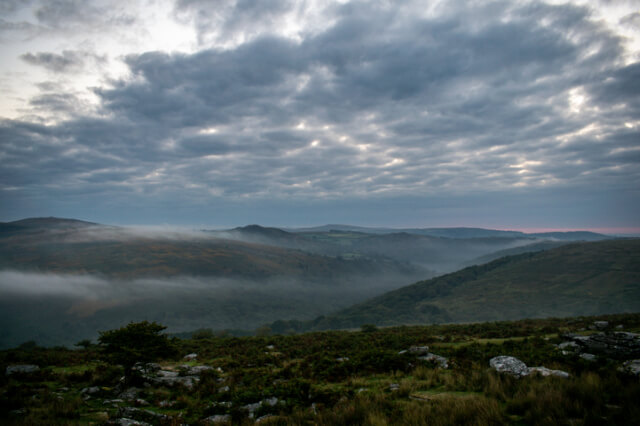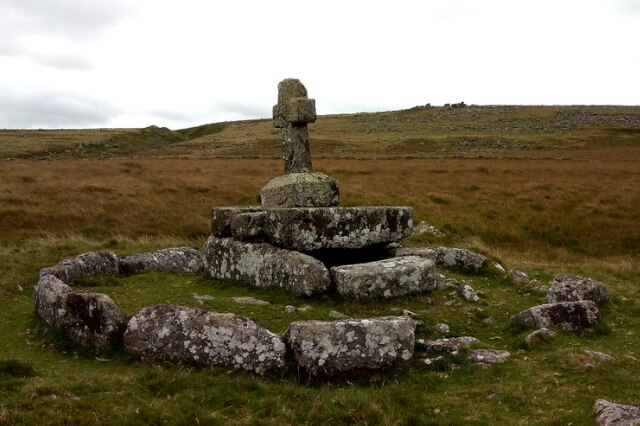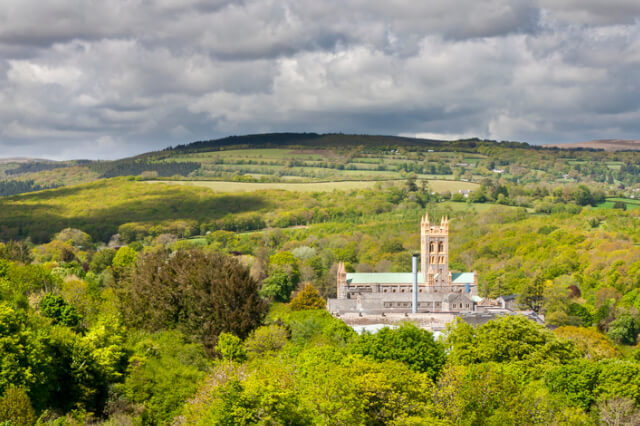The many myths and legends of Dartmoor open up a window into the past.
One generation to the next pass on these age-old Dartmoor myths, via campfire stories to local traditions.
Some Dartmoor legends warn of danger, some discourage bad behaviour, and some simply try to explain the unexplainable.
Dartmoor National Park is a vast, wild, and unspoilt landscape. It has undoubtedly helped to create and encourage these mysterious parts of Devon’s history.
Craggy granite tors and sudden thick mists that appear on the moorland easily incite legend and lore.
We have handpicked some of the best and spookiest Dartmoor legends and myths to inspire your adventures.
Read on to discover the myths and legends of Dartmoor…
- Pixies in Dartmoor Legends
- The Legend of Fitz’s Well
- The Legend of Kitty Jay
- The Ghost of Okehampton Castle
- Cutty Dryer
- The Tale of Childe’s Tomb
- The Coffin Stone
- The Haunting of Buckfast Abbey
- The Hound of the Baskervilles
Pixies in Dartmoor Legends
Pixies, or Piskies are a staple feature throughout many Dartmoor legends.
Their name tends to imply a daintier and more fairy-like image. However, Dartmoor pixies are small and earthy creatures, dressed in rags or leaves.
Dartmoor legends often tell of Pixies coming out at night from their homes in caves, holes and rock formations.
Pixies in general are said to be friendly and helpful creatures, and often provide guidance throughout Dartmoor legends.
One of the most well-known Dartmoor myths around Pixies is from 1853.
It is a said that a mother was travelling with her three children across Dartmoor late at night. When she arrived home, she discovered that one of her children was missing!
Suddenly, two figures dressed in rags and holding small lights led her to beneath a tree.
When she approached the tree, the figures were gone. Nevertheless, there she found her missing child!
The Legend of Fitz’s Well

There is a few versions of this Dartmoor legend, as is common for many of them!
A man named John Fitz and his partner were out on the moors when a mist suddenly befell them.
This mist was not just a natural occurrence; the two travellers were Piskie-led. A mischievous or wronged pixie cast a mist down upon them, and they were utterly lost.
To break the spell, they turned their coats inside out.
When the mist lifted, they found themselves beside a natural spring, which they gladly drank from.
Fitz and his partner were so grateful to have been spared. They erected a simple well house around the spring to commemorate their good fortune, and the tale was permanently added to Dartmoor’s myths and legends.
The Legend of Kitty Jay
The legend of Kitty Jay and her grave is one of sorrow and heartbreak.
Many years ago, it is said in this Dartmoor legend that Kitty Jay was a local farm girl.
She fell pregnant out of wedlock to a local boy. When she informed him of their situation, the boy fled and left her alone.
Kitty Jay was heartbroken and inconsolable, so she took her own life.
Back then, people who took their own life were always buried at a crossroads. This was to confuse the spirit of the deceased and to prevent them from haunting the living.
At her crossroads grave, which you can still find today, fresh flowers appear there every morning.
No one knows who leaves them or why.
This tragic Dartmoor legend was what inspired the book ‘The Apple Tree’ by novelist John Galsworthy, who lived not far from the grave for a time.
The Ghost of Okehampton Castle

The ghost of Lady Howard is the star of this tragic Dartmoor myth.
Legend has it that every night at midnight, Lady Howard takes a single blade of grass from the castle grounds.
She then begins her journey from Okehampton to Tavistock.
Taking the form of a black dog, Lady Howard runs alongside a coach made from the bones of her dead husbands.
She is cursed to make this journey back and forth each night.
Only when every single blade of grass from the castle grounds has been removed can her spirit finally find peace.
Cutty Dryer
This Dartmoor legend comes from the town of Ashburton. Cutty Dryer is the name of an evil sprite.
He lives at King’s Bridge in Ashburton and wreaks havoc on those who pass him at night.
It is said that Cutty Dryer accosts drunks on their way home, and throws them in the river. He even sometimes slits their throats and drinks their blood before throwing them in.
This horrific Dartmoor myth was told to children over the years, to deter them from staying out late at night!
Scary stuff indeed!
The Tale of Childe’s Tomb

A long time ago in this Dartmoor legend, Childe was Lord of the Manor at Plymstock.
He was out hunting on Dartmoor when he was caught in a terrible blizzard. With nowhere to go and the cold starting to take hold, he slayed his horse and took shelter inside its carcass.
Unfortunately, for Childe, this did not save him and he froze to death.
In some versions of this Dartmoor legend, Childe wrote his last will in blood on a nearby granite stone. It stated that whoever found his body and buried it would inherit his estate.
The monks of Tavistock Abbey were the ones to recover his body and planned to bury him in Tavistock.
The people of Plymstock were not pleased to hear that the lands of a Plymstock man would be left to these monks.
A group from Plymstock gathered at the bridge over the River Tavy to intercept the monks of Tavistock. They wanted to gain the body of Childe, and ensure Childe’s lands remained the property of Plymstock Priory.
The monks of Tavistock heard of this ambush. They took a different route, erecting a simple bridge over the Tavy.
This bridge was henceforth known as Guilebridge, as the people of Plymstock were deceived by guile.
It is likely that Childe’s tomb marks the spot where his body was found, as his body is supposed to have been buried in Tavistock.
The Coffin Stone
This Dartmoor myth originates in the village of Dartmeet not far from Widecombe in the Moor.
A long time ago, a truly evil man met his maker.
The coffin bearers carried his coffin to be buried at Widecombe Churchyard. The climb up Dartmeet Hill was steep and the coffin bearers stopped for rest.
They laid his coffin upon the coffin stone as they had done many times before.
It was at this time that the Almighty, being furious that this evil man was to be buried on consecrated ground, sent a huge bolt of lightning down to earth.
The lightning bolt hit the coffin and destroyed it and the body inside.
Only the coffin stone remained asunder, now split in two.
The Haunting of Buckfast Abbey

This eerie Dartmoor legend originates in Buckfastleigh.
Centuries ago, there lived a man named Sir William Kingdon. During his life, he was a great benefactor to the monks at Buckfast Abbey.
In return for his kindness, he asked the monks that upon his death his remains should be buried in the vault of Buckfast Abbey. In addition, he asked that every year on the anniversary of his death, the monks should offer prayers for his soul.
Eventually, Sir William died on the 3rd July. The monks laid his body to rest in the vault of the Abbey.
Whence they returned to the vault the following year on the anniversary of his death to pray for his soul, something very strange happened.
Halfway through the prayer service, a strange mist began to form over the spot where Sir William was buried. The mist slowly took the shape of a man; Sir William Kingdon himself!
The monks nervously continued the service, and only when the last ‘Amen’ was uttered did the ghostly apparition disappear.
No one could explain what happened. It was decided that it was best to never mention it again.
The years went by, and every year the same thing would happen. Every year the monks held their silence on the matter and expected the occurrence with uncertain dread.
The monks were eventually told to leave the abbey by the commissioners of Henry VII.
No one told Sir William of their leaving.
According to the Dartmoor legend, every day on the 3rd July, the mists once again appear.
The monks did return to Buckfast, and like their brothers before them they are bound to silence.
The Hound of the Baskervilles
Perhaps one of the most well-known Dartmoor myths and legends is the origins of Sir Arthur Conan Doyle’s Hound of the Baskervilles.
The famous novelist was inspired to write this Sherlock Holmes novel following a stay at the Duchy Hotel in Princetown. Nowadays this hotel is the High Moorland Visitor Centre.
It was here that Doyle heard the Dartmoor myth of Squire Cabell.
Cabell was known to be an evil man and the Dartmoor legends say that when he died, a pack of black hounds ran howling across Dartmoor.
The body of Cabell was buried in Buckfastleigh.
His coffin had to be entombed in a small building to stop him from rising and riding out with his hounds.
When you book a holiday to Dartmoor with Helpful Holidays, you are in the hands of the experts.
We have 40 years of holiday letting experience, and are based in the heart of Dartmoor National Park in Chagford.
There’s a myriad of things to do in Dartmoor; it’s a fantastic choice for a UK holiday.
Book your Dartmoor holiday with the experts at Helpful Holidays!
Reading Tom – CC BY 2.0; Daniel Evans – Public Domain Mark 1.0